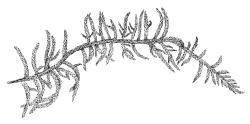Elements in the following family description are taken from Rohrer (1985).
Plants medium-sized to robust, forming loose to compact wefts. Stems prostrate, ascendant, or erect, often with ascending-arching innovations, irregularly or pinnately branched, sometimes frondose, usually with a central strand. Stem and branch leaves often differentiated, usually serrate to serrulate at margins. Laminal cells elongate, prosenchymatous, smooth or prorate, thin- to rather thick-walled, often ± porose; alar cells differentiated or not. Costae mostly double and strong. Paraphyllia present or not. Pseudoparaphyllia often present and foliose.
Dioicous. Perichaetia restricted to stems. Perigonia bud-like and scattered on stems and branches. Setae elongate and smooth; capsules mostly curved and asymmetric. Operculum conic-apiculate or rostrate. Peristome double; exostome teeth yellow to red-brown, lanceolate, shouldered, and bordered, often reticulate on outer surface; endostome with a high basal membrane; segments mostly broad, keeled, and narrowly or broadly perforate; cilia mostly present, 1–4. Calyptra cucullate and smooth.
For many decades, there has been little agreement concerning the delimitation of the Hylocomiaceae (grounded by Hylocomium) and the related Rhytidiaceae. Several genera, all of them exclusively northern hemisphere in their natural distribution (N.Z. populations of H. splendens excepted), have been placed by different authors in both families (and some also in the Hypnaceae). These genera include Rhytidiadelphus (which occurs as an adventive in N.Z.), some ecologically important and widely distributed northern hemisphere genera as Rhytidium, Pleurozium, Gollania, and others of more restricted distribution. The Hylocomiaceae were treated by Brotherus (1925) to include seven genera but to exclude Rhytidiadelphus, Rhytidium, Pleurozium, and Gollania. Crum & Anderson (1981) treated four genera in the Hylocomiaceae for eastern North America and presented an interesting overview of the problems surrounding its delineation: "We have combined the Hylocomiaceae and the Rhytidiaceae and have taken a conservative view of the genera, in distinct contrast to concepts presented by Fleischer and followed by Brotherus and many more modern authors. The two families, separate or combined, consist of genera anomalous in respect to the Hypnaceae and not clearly related to any other family of the Hypnobryales. The genera defy definition except in relation to one another." The family was reviewed by Crum’s student J. Rohrer (1985), who recognised 12 genera (including Rhytidiadelphus, Rhytidium, and Pleurozium, but excluding Gollania). Goffinet et al. (2009) presented an expanded family concept of 15 genera, some of which were recently described; they also, controversially, included the large genus Ctenidium in the Hylocomiaceae.
In this Flora the apparently indigenous Hylocomium and the adventive Rhytidiadelphus are treated in the Hylocomiaceae, while Ctenidium (with only one indigenous species in N.Z.) is retained in the Hypnaceae. The Hylocomiaceae are widely distributed in temperate to cold parts of the northern hemisphere and some tropical highlands.
Two genera and three species (two clearly adventive) are known to occur in N.Z. All three species are known here only by plants of a single sex; no sporophytes for any of the species have been found regionally.
| 1 | Plants medium-sized; stem leaves erect and overlapping, neither cordate nor clasping at base, <2.0 mm; branch leaves strongly differentiated from stem leaves, broadly acute or rounded at apices; paraphyllia densely covering stems and branches; known only on North I. and above 1200 m. | Hylocomium |
| 1' | Plants coarse and robust; stem leaves either wide-spreading or squarrose, cordate at base, >2.8 mm; branch leaves sometimes narrower but not strongly differentiated from stem leaves, acute at apices; paraphyllia absent; known only on South I., from low to mid-elevation sites | Rhytidiadelphus |
| Category | Number |
|---|---|
| Indigenous (Non-endemic) | 1 |
| Exotic: Fully Naturalised | 2 |
| Total | 3 |




